Dominique Lévy's new show explores the powerful parallels between two Japanese artists separated by a generation
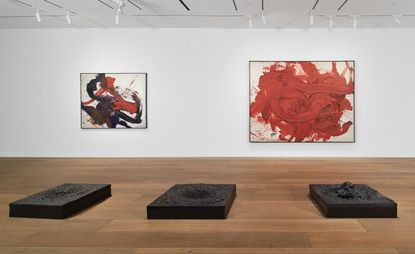
The elusive and the explosive rarely overlap, but when they do, the effect is devastating. It's a recipe for stealthily volatile events such as nuclear meltdowns, sonic booms, and sporadically occurring genetic mutations - the ones on which entire ecosystems may pivot - and it is at violent play in a new exhibition that brings together for the first time the work of Japanese artists Kazuo Shiraga and Satoru Hoshino.
On view through 4 April at New York's Dominique Lévy gallery and curated by Koichi Kawasaki, 'Body and Matter' finds convincing parallels between artists separated by a generation and their approach to the avant-garde (the late Shiraga joined the Gutai movement in 1954, while Hoshino, now 69, was active with the Sōdeisha ceramics group in the 1970s). Both men got down and dirty in their endeavours to break with artistic tradition, developing methods that achieved a purity of expression while revelling in their links to the human body. The roiling abstract canvases of Shiraga and the sooty-yet-lustrous sculptures of Hoshino do not merely expose traces of the artists' hands - or feet or fingers - they pulsate with them.
'In Tokyo in 1955, we find the young Shiraga literally wrestling in clay,' says gallerist Dominique Lévy, referring to the artist's sensational performance piece, 'Challenging Mud'. 'He's creating a sculpture using his body well before any Allan Kaprow happening, well before even Yves Klein uses his body as a living paintbrush in 1961, well before I think anyone.' A few years later, Shiraga was hurling oil paint on the floor and, suspended from the ceiling, manipulating it with his feet to create works such as 'Suiju' (1985), a ruddy crimson fireball that strains against the bounds of its wall-sized canvas.
'I call them performance paintings, because for Shiraga, the canvas was a stage,' says art historian Reiko Tomii, who contributed an essay to the exhibition catalogue, out next month along with a Shiraga mega-monograph that Lévy is publishing in collaboration with Axel Vervoordt Gallery. 'It was a new possibility for painting, going beyond modernism.'
Dotted like a median along the floor of one room of the exhibition is a series of Hoshino sculptures from 1989 and 1990. With titles such as 'Appeared Landscape' and 'Outline of Background IV', they are served up on rectangular slabs of smoked earthenware that have the ominous gleam of obsidian. Yet rather than appear charred, these blackened works come alive with the petal-like indentations created by Oshino's finger as he poked and prodded his forms into being. 'When hands touch clay, transforming it,' the artist has said, 'images begin to fly up around it.'
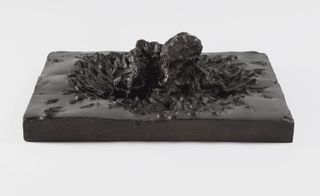
Dotted like a median along the floor of one room of the exhibition is a series of Hoshino sculptures from 1989 and 1990, served up on rectangular slabs of smoked earthenware that have the ominous gleam of obsidian. Pictured is 'Outline of Background IV', by Satoru Hoshino, 1990.

Detail of 'Outline of Background IV', by Satoru Hoshino, 1990. These blackened works come alive with the petal-like indentations created by Oshino's finger as he poked and prodded his forms into being.
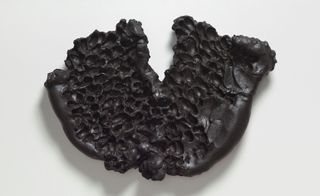
'Surfacing Bird (Flight of W)', by Satoru Hoshino, 1991.
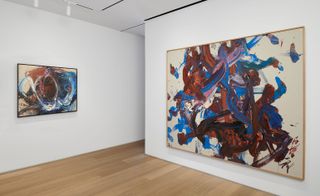
Hoshino's works are juxtaposed with the roiling abstract canvases of Shiraga. Both men broke with artistic tradition, developing methods that achieved a purity of expression while revelling in links to the human body.

'Tenkosei Kaosho', by Kazuo Shiraga, 1962. Shiraga hurled oil paint on the floor and, suspended from the ceiling, manipulating it with his feet to create his works.

Shiraga, pictured here in his studio in 1960, used his body as a living paint brush.
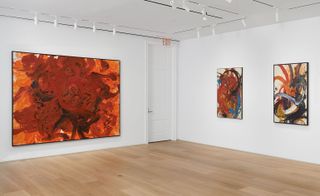
'For Shiraga, the canvas was a stage,' says art historian Reiko Tomii, who contributed an essay to the exhibition catalogue. 'It was a new possibility for painting, going beyond modernism.'
ADDRESS
Dominique Lévy
909 Madison Avenue
New York
NY 10021
United States
Wallpaper* Newsletter
Receive our daily digest of inspiration, escapism and design stories from around the world direct to your inbox
-
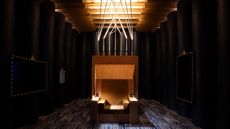 David Lynch presents 'A Thinking Room' at the Salone del Mobile
David Lynch presents 'A Thinking Room' at the Salone del MobileHere's a first look at the David Lynch Salone del Mobile 2024 installation, a cinematic experience within the fair curated by Antonio Monda
By Laura May Todd Published
-
 Riva El-Iseo is the legendary boat builder’s first fully-electric motor yacht
Riva El-Iseo is the legendary boat builder’s first fully-electric motor yachtThe Riva El-Iseo electric speedboat blends classic Italian lines with a silent, powerful and zero-emission powertrain
By Jonathan Bell Published
-
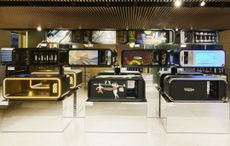 Technogym Home Bench 40 ways: designers interpret the home exercise classic
Technogym Home Bench 40 ways: designers interpret the home exercise classicTechnogym marks its 40 anniversary with 40 special editions of its Home Bench created in collaboration with international creatives
By Rosa Bertoli Published
-
 Olafur Eliasson inaugurates Azabudai Hills Gallery in Tokyo
Olafur Eliasson inaugurates Azabudai Hills Gallery in TokyoOlafur Eliasson marks launch of Azabudai Hills Gallery, in Tokyo’s major new district, with a show of elemental strength
By Danielle Demetriou Published
-
 Photographer David Abrahams captures quiet moments in Japan for his new London show
Photographer David Abrahams captures quiet moments in Japan for his new London show‘Kyushu’ is a new show from photographer David Abrahams that documents his trip to a town on the Japanese island
By Mary Cleary Published
-
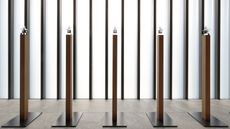 Hiroshi Sugimoto: ‘The deeper I explore Shinto and Buddhist art, the more it reveals the shallowness of contemporary art’
Hiroshi Sugimoto: ‘The deeper I explore Shinto and Buddhist art, the more it reveals the shallowness of contemporary art’‘Hiroshi Sugimoto – The Descent of the Kasuga Spirit’, at the Kasuga-Taisha shrine in Nara, Japan, sees the acclaimed photographer draw on Japan’s spiritual past and present
By Minako Norimatsu Published
-
 Artist’s Palate: Chiharu Shiota’s recipe for okonomiyaki
Artist’s Palate: Chiharu Shiota’s recipe for okonomiyakiGet tangled up in Chiharu Shiota’s recipe for okonomiyaki, from our January 2023 issue’s Artist’s Palate feature, a Wallpaper* homage to our favourite contemporary art
By TF Chan Published
-
 ‘East Meets West’: artists Samiro Yunoki and Kori Girard unite at Ace Hotel Kyoto
‘East Meets West’: artists Samiro Yunoki and Kori Girard unite at Ace Hotel KyotoArt exhibition, ‘East Meets West’ at Ace Hotel Kyoto marks Japanese artist Samiro Yunoki’s 100th birthday, in dialogue with new works by American artist Kori Girard
By Pei-Ru Keh Last updated
-
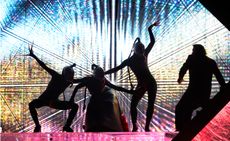 teamLab: how a Tokyo art collective pioneered an immersive art boom
teamLab: how a Tokyo art collective pioneered an immersive art boomWith an operatic intervention and a show at Pace Geneva, teamLab, the now-700-strong Tokyo-based collective that blazed a trail for experiential, tech-fuelled art, continues to value ‘physical interaction in physical space’
By Nick Compton Last updated
-
 Tanabe Chikuunsai IV wraps Casa Loewe Barcelona in 6,000 strips of tiger bamboo
Tanabe Chikuunsai IV wraps Casa Loewe Barcelona in 6,000 strips of tiger bambooInside the newly revamped Casa Loewe Barcelona, Japanese artist Tanabe Chikuunsai IV reflects on family traditions and environmental destruction with a staggering bamboo installation
By Malaika Byng Last updated
-
 Botanical sculptor Azuma Makoto creates a sculptural ecosystem at Mexico’s SFER IK
Botanical sculptor Azuma Makoto creates a sculptural ecosystem at Mexico’s SFER IKJapanese artist Azuma Makoto’s largest flower sculpture to date responds to SFER IK’s unique biophilic design and the surrounding wilderness
By Pei-Ru Keh Last updated